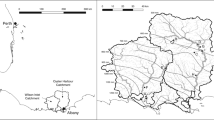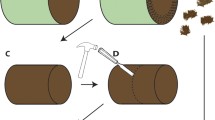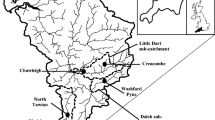Abstract
Mass fluxes from the ground surface can play a vital role in influencing groundwater ecosystems. Rates of delivery may influence intact ecosystem composition, while fluxes of substances associated with anthropogenic activity may critically alter the functioning of associated microbial assemblages. Field-based tracing experiments offer a valuable means of understanding mass transport rates and mechanisms, particularly in complex heterogeneous epikarst systems overlying vulnerable fissured aquifers. A short-term tracer experiment monitoring solute and particle tracer concentrations after they passed through a 10-m-thick sequence of limestone, capped by a thin soil, revealed rapid travel times and variable attenuation rates for the substances employed. Results demonstrated that particle tracers have shorter average travel times and can reach the subsurface in higher concentrations and over shorter times than non-reactive solutes. High recovery rates for the bacterial tracer Ralstonia eutropha H16 contrasted strongly with those of similarly sized fluorescent polystyrene microspheres, highlighting the importance of physico-chemical surface characteristics of particle tracers. Complementary laboratory batch experiments examined the role played by organic and inorganic soil/rock surfaces on particle tracer attenuation. Findings suggest that biofilms may significantly promote transport of particulate material below ground, i.e., the delivery of allochthonous microorganisms to karst groundwater.
Résumé
Les flux de masse depuis la surface peuvent jouer un rôle vital en influençant les écosystèmes des eaux souterraines. Les taux de restitution peuvent influencer des constitutions intactes d’écosystèmes, alors que les flux de substances associés aux activités anthropiques peuvent gravement altérer le fonctionnement des groupements microbiologiques associés. Les essais de traçage sur le terrain constituent une méthode précieuse pour comprendre les proportions et les mécanismes des transports de masse, notamment dans les systèmes epikarstiques complexes et hétérogènes recouvrant des aquifères fissurés et vulnérables. Un essai de traçage à court terme à travers une tranche de 10 m de calcaire recouverte par un sol peu épais, avec suivi des concentrations en traceurs particulaires et dissous, a mis en évidence des temps de transit rapides, et des taux d’atténuation variables selon les substances employées. Les résultats démontrent que les traceurs particulaires ont des temps de transit moyen plus courts, et peuvent atteindre la subsurface en concentrations plus élevées et en des temps plus courts que les solutés inertes. Les taux de restitution élevés du traceur bactérien Ralstonia eutropha H16 différaient de ceux des microsphères de polystyrène fluorescentes de taille identique, soulignant l’importance des caractéristiques physico-chimiques superficielles des traceurs particulaires. Des expériences complémentaires en laboratoire ont examiné le rôle des surfaces organiques et inorganiques des roches et sols dans l’atténuation des traceurs particulaires. Les resultats suggèrent que les biofilms sont susceptibles de favoriser significativement le transport des matériaux particulaires dans le sous-sol, c’est-à-dire l’apport de microorganismes allochtones aux eaux souterraines karstiques.
Zusammenfassung
Stoffeintrag von der Oberfläche stellt für Grundwasserökosysteme einen maßgeblichen Faktor sowohl für deren natürliche Zusammensetzung, als auch für negative Auswirkungen durch anthropogene Einflüsse dar. Tracerversuche können in diesem Zusammenhang einen substantiellen Beitrag zur Charakterisierung des Stofftransportes und zum Verständnis der zugrundeliegenden Mechanismen leisten. Dies gilt vor allem für komplexe heterogene Systeme, wie z.B. Epikarst als Teil vulnerabler Grundwasserleiter in Karbonatgesteinen. In der vorliegenden Studie wurde der Stofftransport in den obersten 10 m der vadosen Zone eines nur von einer dünnen Bodenschicht bedeckten Karstgrundwasserleiters untersucht. Die Eingabe von löslichen und partikulären Tracern in das System ergab insgesamt hohe Fließgeschwindigkeiten mit allerdings sehr unterschiedlichem Transportverhalten für die einzelnen Stoffe. Dabei erreichten die Partikeltracer den Untergrund schneller und zum Teil in höheren relativen Konzentrationen als der konservative lösliche Tracer. Insbesondere wies der mikrobielle Tracer Ralstonia eutropha H16 einen deutlich höheren Wiedererhalt als gleichgroße Mikrosphären auf, was die Bedeutung der spezifischen physikalisch-chemischen Eigenschaften von Partikeloberflächen auf das Transportverhalten verdeutlicht. Ergänzende Laborversuche zeigten zudem, dass die Eigenschaften der Boden- und Gesteinsoberflächen für den Rückhalt von Partikeln eine entscheidende Rolle spielen. Insgesamt lassen die Ergebnisse den Schluss zu, dass die Ausbildung eines Biofilms die Mobilität von Partikeln in signifikanter Weise erhöhen und somit den Eintrag von allochthonen Mikroorganismen in den Karstgrundwasserleiter begünstigen kann.
Resumen
Los flujos de masa desde la superficie del suelo pueden jugar un papel vital influenciando los ecosistemas de aguas subterráneas. Las tasas de distribución pueden influenciar la composición de ecosistemas intactos, mientras que los flujos de sustancias asociadas con la actividad antrópica pueden alterar críticamente el funcionamiento de los conjuntos microbiológicos asociados. Experimentos de trazadores basados en campo ofrecen un valioso método para comprender las tasas de transporte de masa y sus mecanismos, particularmente en sistemas epikársticos complejos y heterogéneos cubiertos por acuíferos fracturados vulnerables. Un experimento con trazador a corto plazo monitorizando el soluto y las concentraciones de partículas trazadoras después que pasaron a través de una secuencia de calizas de 10 metros de potencia, cubierto por un suelo poco potente, reveló la existencia de tiempos de tránsito rápidos y tasas de atenuación variables para las sustancias empleadas. Los resultados demostraron que las partículas trazadoras tienen tiempos de tránsito medios más cortos y pueden alcanzar el subsuelo en concentraciones más altas y en tiempos más cortos que los solutos no reactivos. Tasas de recuperación altas para el trazador bacteriano Ralstonia eutropha H16 contrastaron de forma notable con micro esferas de poliestireno fluorescente de un tamaño similar, poniendo de manifiesto la importancia de las características de la superficie físicoquímica en los trazadores particulados. Experimentos batch complementarios en laboratorio estudiaron el papel que juegan las superficies orgánicas e inorgánicas suelo/roca en la atenuación de los trazadores particulados. Los tests sugieren que los biofilms pueden fomentar significantemente el transporte de material particulado bajo el suelo, esto es, la llegada de microorganismos alóctonos al agua subterránea cárstica.
摘要
来自地面的物质流可以对地下水生态系统产生重要影响。流速可能会影响生态系统的完整性, 而与人类活动有关的物质流则可能使微生物组合的功能发生重大改变。野外示踪实验为研究质量流率提供了一种重要手段, 尤其对于下伏脆性裂隙含水层的非均质岩溶系统, 更是如此。在10 m厚的石灰岩层中开展了短期示踪试验, 岩层上覆薄层粘土, 让溶质和颗粒示踪剂通过岩层并对其浓度进行监测。试验表明运移速度很快, 示踪剂衰减程度各处不同。结果表明, 较之非反应溶质, 颗粒示踪剂在较短的时间和以较高的浓度到达地下。细菌示踪剂Ralstonia eutropha H16的高回收率与具有相似粒径的荧光聚丙乙烯微球形成强烈对比, 突显颗粒示踪剂表面物理化学性质重要性。补充的实验室批量实验检验了有机和无机土壤/岩石表面对于颗粒示踪剂的消减作用。试验表明生物膜可能会显著促进颗粒物质在地下的运移, 即 allochtonous 微有机体向岩溶地下水的迁移。
Resumo
Os fluxos mássicos a partir da superfície do terreno podem ter um papel vital na afectação dos ecossistemas em águas subterrâneas. As taxas de fornecimento podem influenciar a composição de ecossistemas intactos, enquanto o fluxo de substâncias associadas à actividade antropogénica podem alterar de forma crítica o funcionamento das associações microbiológicas associadas. Os ensaios de campo com traçadores oferecem um valioso meio de compreensão das taxas e mecanismos de transporte mássico, particularmente em sistemas epicársicos heterogéneos complexos sobrepostos a aquíferos fissurados vulneráveis. Um ensaio de curta duração com traçadores, que monitorizou as concentrações de solutos e de partículas como traçadores depois de passarem através de uma sequência de calcário com 10 metros de espessura recoberta por um solo delgado, revelou, para as substâncias empregues, tempos de trânsito curtos e taxas de atenuação variáveis. Os resultados demonstram que as partículas traçadoras têm tempos de trânsito médio mais baixos e podem atingir a sub-superfície em maiores concentrações e em tempos mais curtos que solutos não reactivos. As altas taxas de recuperação do traçador bacteriano Ralstonia eutropha H16 contrastam fortemente com as obtidas com micro-esferas fluorescentes de poliestireno com dimensões similares, destacando a importância das características físico-químicas das superfícies das partículas dos traçadores. Experiências seriadas de laboratório examinaram o papel das superfícies solo/rochas orgânicas e inorgânicas na atenuação das partículas de traçador. Os ensaios sugerem que os biofilmes podem promover significativamente o transporte de material particulado abaixo da superfície, i.e., o fornecimento de microrganismos alóctones à água subterrânea cársica.







Similar content being viewed by others
References
Aragno M, Schlegel HG (1992) The mesophilic hydrogen-oxidizing (Knallgas) bacteria. In: Balows A, Trüper HG, Dworkin M, Harder W, Schleifer KH (eds) The Prokaryotes. Springer, Berlin Heidelberg New York, pp 344–384
Auckenthaler A, Raso G, Huggenberger P (2002) Particle transport in a karst aquifer: natural and artificial tracer experiments with bacteria, bacteriophages and microspheres. Water Sci Technol 46(3):131–138
Bengtsson G, Lindqvist R (1995) Transport of soil bacteria controlled by density-dependent sorption kinetics. Water Resour Res 31(5):1247–1256
Castegnier F, Ross N, Chapuis RP, Deschênes L, Samson R (2006) Long-term persistence of a nutrient-starved biofilm in a limestone fracture. Water Res 40(5):925–934
Champ DR, Schroeter J (1988) Bacterial transport in fractured rock–a field-scale tracer test at the Chalk River Nuclear Laboratories. Water Sci Technol 20(11–12):81–87
Drew D, Hötzl H (eds) (1999) Karst hydrogeology and human activities: impacts, consequences and implications. Intern Contr to Hydrogeology 20, Balkema, Rotterdam, 322 pp
Elimelech M, Gregory J, Jia X, Williams R (1995) Particle deposition and aggregation. Butterworth-Heinemann, Oxford 441 pp
Enciso-Moreno JA, Pernas-Buitrón N, Ortiz-Herrera M, Coria-Jiménez R (2004) Identification of Serratia marcescens populations of nosocomial origin by RAPD-PCR. Arch Med Res 35(1):12–17
Flynn R (2003) Virus transport and attenuation in perialpine gravel aquifers. PhD Thesis, Centre of Hydrogeology, University of Neuchâtel, Switzerland, 178 pp
Flynn R, Sinreich M (2005) Virus transport through fissured limestone: a collision course? Geophys Res Abstr 7:09488
Flynn R, Cornaton F, Hunkeler D, Rossi P (2004) Bacteriophage transport through a fining-upwards sedimentary sequence: laboratory experiments and simulation. J Cont Hydr 74(1–4):231–252
FOEN (2008) Hydrogeological sketch of Switzerland. Federal Office for the Environment FOEN, Bern, Switzerland
Foppen JWA, Schijven JF (2006) Evaluation of data from the literature on the transport and survival of Escherichia coli and thermotolerant coliforms in aquifers under saturated conditions. Water Res 40(3):401–426
Foppen JW, van Herwerden M, Schijven J (2007) Measuring and modeling straining of Escherichia coli in saturated porous media. J Cont Hydr 93(1–4):236–254
Foppen JWA, van Herwerden M, Kebtie M, Noman A, Schijven JF, Stuyfzand PJ, Uhlenbrook S (2008) Transport of Escherichia coli and solutes during waste water infiltration in an urban alluvial aquifer. J Cont Hydr 1–2(7):1–16
Franklin RB, Mills AL (2005) Structural and functional responses of a sewage microbial community to dilution-induced reductions in diversity. Microb Ecol 52(2):280–288
Ginn TR, Wood BD, Nelson KE, Scheibe TD, Murphy EM, Clement TB (2002) Processes in microbial transport in the natural subsurface. Adv Water Resour 25(8–12):1017–1042
Goldscheider N, Hunkeler D, Rossi P (2006) Review: microbial biocenoses in pristine aquifers and an assessment of investigative methods. Hydrog J 14(6):926–941
Gómez-Suárez C, Pasma J, van der Borden AJ, Wingender J, Flemming HC, Busscher HJ, van der Mei HC (2002) Influence of extracellular polymeric substances on deposition and redeposition of Pseudomonas aeruginosa to surfaces. Microbiology 148(4):1161–1169
Harvey RW, George LH, Smith RL, LeBlanc DR (1989) Transport of microspheres and indigenous bacteria through a sandy aquifer: results of natural- and forced-gradient tracer experiments. Environ Sci Technol 23(1):51–56
Harvey RW, Harms H (2002) Tracers in groundwater – use of microorganisms and microspheres. In: Bitton G (ed) Encyclopedia of environmental microbiology 6. Wiley, New York, pp 3194–3202
Harvey RW, Kimmer NE, MacDonald D, Metge DW, Bunn A (1993) Role of physical heterogeneity in the interpretation of small-scale laboratory and field observations of bacteria, microbial-sized microsphere, and bromide transport through aquifer sediments. Water Resour Res 29(8):2713–2721
Hötzl H, Käss W, Reichert B (1991) Application of microbial tracers in groundwater studies. Water Sci Technol 24(2):295–300
Howard K (2003) Bacteria transmission in fissured carbonates: fatal consequences in Walkerton, Ontario. In: Krásný J, Hrkal Z, Bruthans J (eds) Groundwater in fractured rocks. Prague, pp 347–348
Johnson WP, Blue KA, Logan BE, Arnold RG (1995) Modeling bacterial detachment during transport through porous media as a residence-time-dependent process. Water Resour Res 31(11):2649–2658
Käss W (1998) Tracing technique in geohydrology. Balkema, Rotterdam 581 pp
Keswick BH, Wang DS, Gerba CP (1982) The use of microorganisms as ground-water tracers: a review. Ground Water 20(2):142–149
Klimchouk AB (2004) Towards defining, delimiting and classifying epikarst: Its origin, processes and variants of geomorphic evolution. Speleogenesis and Evolution of Karst Aquifers 2(1), http://www.speleogenesis.info
Knoll D, Schreiber L (1998) Influence of epiphytic micro-organisms on leaf wettability: wetting of the upper leaf surface of Juglans regia and of model surfaces in relation to colonization by micro-organisms. New Phyt 140(2):271–282
Kretzschmar R, Borkovec M, Grolimund D, Elimelech M (1999) Mobile subsurface colloids and their role in contaminant transport. Adv Agron 66:121–193
Lindqvist R, Bengtsson G (1995) Diffusion-limited and chemical-interaction-dependent sorption of soil bacteria and microspheres. Soil Biol Biochem 27(7):941–948
Macler BA, Merkle JC (2000) Current knowledge on microbial pathogens and their control. Hydrog J 8(1):29–40
Mahler BJ, Personné J-C, Lods GF, Drogue C (2000) Transport of free and particulate-associated bacteria in karst. J Hydrol 238(3–4):179–193
Mailloux BJ, Fuller ME, Onstott TC, Hall J, Dong H, DeFlaun MF, Streger SH, Rothmel RK, Green M, Swift DJP, Radke J (2003) The role of physical, chemical, and microbial heterogeneity on the field-scale transport and attachment of bacteria. Water Resour Res 39(6):1142
McDowell-Boyer LM, Hunt JR, Sitar N (1986) Particle transport through porous media. Water Resour Res 22(13):1901–1921
McKay LD, Sanford WE, Strong JM (2000) Field-scale migration of colloidal tracers in a fractured shale saprolite. Ground Water 38(1):139–147
Mills AL, Herman JS, Hornberger GM, DeJesús TH (1994) Effect of solution ionic strength and iron coatings on mineral grains on the sorption of bacterial cells to quartz sand. Appl Environ Microbiol 60(9):3300–3306
Murphy EM, Ginn TR (2000) Modeling microbial processes in porous media. Hydrog J 8(1):142–158
Personné J-C, Poty F, Vaute L, Drogue C (1998) Survival, transport and dissemination of Escherichia coli and Enterococci in a fissured environment. Study of a flood in a karstic aquifer. J Appl Microbiol 84(3):431–438
Personné J-C, Poty F, Mahler BJ, Drogue C (2004) Colonization by aerobic bacteria in karst: Laboratory and in situ experiments. Ground Water 42(4):526–533
Pohlmann A, Fricke WF, Reinecke F, Kusian B, Liesegang H, Cramm R, Eitinger T, Ewering C, Pötter M, Schwartz E, Strittmatter A, Voss I, Gottschalk G, Steinbüchel A, Friedrich B, Bowien B (2006) Genome sequence of the bioplastic-producing “Knallgas” bacterium Ralstonia eutropha H16. Nat Biot 24(10):1257–1262
Pronk M, Goldscheider N, Zopfi J (2006) Dynamics and interaction of organic carbon, turbidity and bacteria in a karst aquifer system. Hydrog J 14(4):473–484
Renken RA, Cunningham KJ, Zygnerski MR, Wacker MA, Shapiro AM, Harvey RW, Metge DW, Osborn CL, Ryan JN (2005) Assessing the vulnerability of a municipal well field to contamination in a karst aquifer. Environ Eng Geosci 11(4):319–331
Schaumann GE, Braun B, Kirchner D, Rotard W, Szewzyk U, Grohmann E (2007) Influence of biofilms on the water repellency of urban soil samples. Hydrol Process 21(17):2276–2284
Scheibe TD, Dong H, Xie YL (2007) Correlation between bacterial attachment rate coefficients and hydraulic conductivity and its effect on field-scale bacterial transport. Adv Water Resour 30(6–7):1571–1582
Scholl MA, Mills AL, Hermann JS, Hornberger GM (1990) The influence of mineralogy and solution chemistry on the attachment of bacteria to representative aquifer materials. J Cont Hydr 6(4):321–336
Shevenell L, McCarthy JF (2002) Effects of precipitation events on colloids in a karst aquifer. J Hydrol 255(1–4):50–68
Sinreich M, Flynn R (2006) Comparative tracing experiments to investigate epikarst structural and compositional heterogeneity. Proc 8th Conf Limestone Hydrogeology, Presses universitaires de Franche-Comté, Besançon, pp 253–258
Toran L, Palumbo AV (1992) Colloid transport through fractured and unfractured laboratory sand columns. J Cont Hydr 9(3):289–303
Ward RS, Harrison I, Leader RU, Williams AT (1997) Fluorescent microspheres as tracer of colloidal and particulate materials: examples of their use and developments in analytical technique. In: Kranjc A (ed) Tracer hydrology ‘97. Balkema, Rotterdam, pp 99–103
Ward RS, Lawrence AR, Williams AT, Barker JA (2001) Transport of microbiological contaminants in the unsaturated zone of the Chalk aquifer: investigation by tracer test. In: Seiler KP, Wohnlich S (eds) New approaches characterizing groundwater flow. Balkema, Rotterdam, pp 221–224
Yao K, Habibian MT, O’Melia CR (1971) Water and wastewater filtration: concepts and applications. Environ Sci Technol 5(11):1105–1112
Acknowledgements
The results presented in this paper form part of a research program at the Centre of Hydrogeology, University of Neuchâtel, dealing with flow and contaminant transport in the karst vadose zone, which is funded by the Swiss Canton of Solothurn. The authors appreciate the invitation to contribute to the present Hydrogeology Journal Theme Issue, and wish to thank the guest editors and two anonymous reviewers for very constructive comments, improving the structure of the paper.
Author information
Authors and Affiliations
Corresponding author
Rights and permissions
About this article
Cite this article
Sinreich, M., Flynn, R. & Zopfi, J. Use of particulate surrogates for assessing microbial mobility in subsurface ecosystems. Hydrogeol J 17, 49–59 (2009). https://doi.org/10.1007/s10040-008-0362-6
Received:
Accepted:
Published:
Issue Date:
DOI: https://doi.org/10.1007/s10040-008-0362-6




